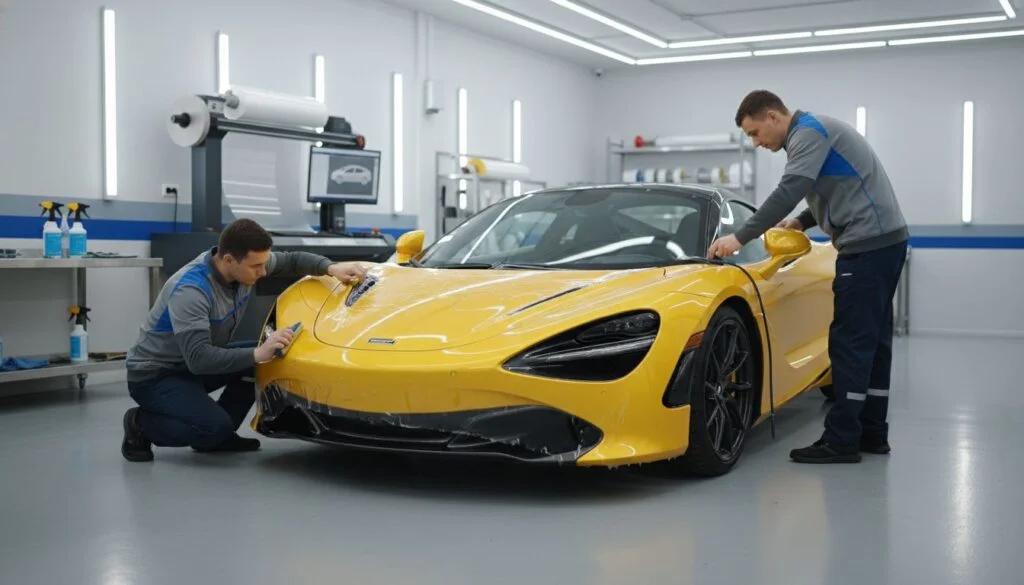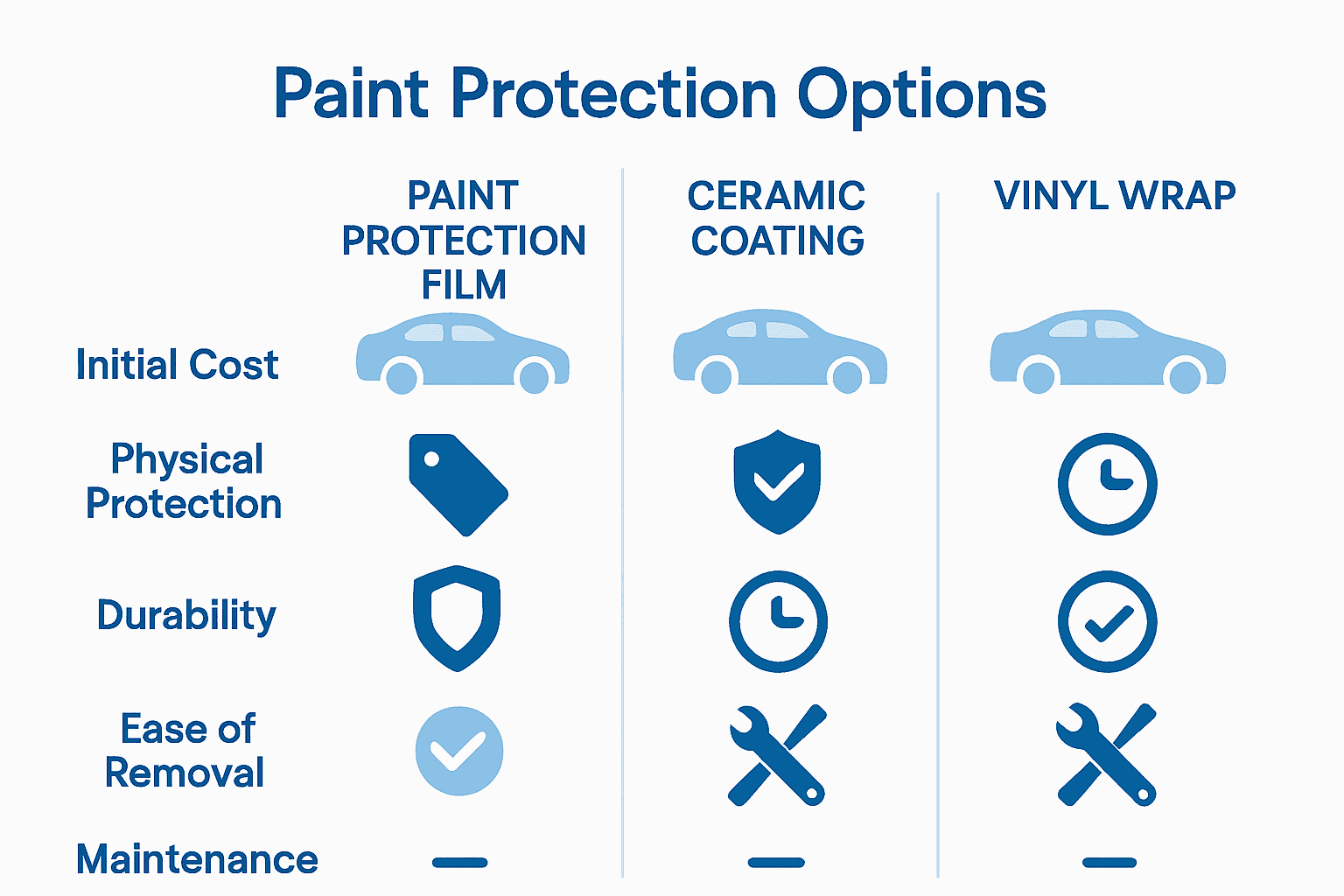
Did you know that experts estimate car protection film can reduce exterior paint damage by up to 90 percent? Keeping a vehicle looking new is more challenging than ever with constant threats from rocks, UV rays, and harsh weather. Paint protection film addresses these problems by providing a nearly invisible shield for your car. Drivers and professionals alike can discover how this advanced film supports long-lasting beauty, saves on costly repairs, and helps maintain resale value.
Table of Contents
- Defining Car Protection Film and Its Benefits
- Types of Paint Protection Film Available
- Factors Influencing Car Protection Film Pricing
- Professional Installation vs. DIY Costs
- Cost Comparison: PPF Alternatives and Long-Term Value
Key Takeaways
| Point | Details |
|---|---|
| Paint Protection Film (PPF) | PPF is a transparent layer that protects a vehicle’s paint from scratches, UV rays, and environmental damage, preserving its aesthetic and resale value. |
| Varieties of PPF | Different types of PPF, such as clear, gloss, matte, self-healing, and hydrophobic, cater to various protection needs and aesthetic preferences. |
| Cost Factors | Pricing for PPF depends on material quality, vehicle complexity, coverage area, and brand reputation, which professionals should consider when offering services. |
| Installation Choices | Professional installation ensures optimal results and minimizes errors, while DIY options may save costs but require skill, making professional services more valuable long-term. |
Defining Car Protection Film and Its Benefits
Paint Protection Film (PPF) represents an advanced automotive preservation technology designed to shield a vehicle’s exterior from environmental damage. According to Innovated Design, PPF is a “transparent, thin layer of thermoplastic urethane applied to a vehicle’s surface, acting as a barrier against scratches, stone chips, and UV rays.”
This innovative protective solution offers comprehensive defense for your vehicle’s paintwork. Car protection film functions as an invisible shield that absorbs impacts and prevents direct damage to the underlying paint surface. The film’s key benefits include:
- Protecting against rock chips and road debris
- Blocking harmful ultraviolet radiation
- Preventing scratches and minor abrasions
- Maintaining the vehicle’s original paint quality
- Preserving resale value by preventing aesthetic deterioration
As Auto Cosmetics explains, PPF is “also known as clear bra” and serves a critical role in “preserving the paint’s appearance and resale value.” Professional installers understand that this thin, adaptable film can be strategically applied to high-impact areas like the front bumper, hood, side mirrors, and door edges, providing targeted protection where vehicles experience the most potential damage.
For automotive professionals and enthusiasts, understanding how PPF works becomes essential in recommending the most effective protection strategies for different vehicle types and usage conditions. The film’s advanced technology ensures that your vehicle maintains its showroom shine while defending against the daily wear and tear of road travel.
Types of Paint Protection Film Available
Paint Protection Films (PPF) come in a variety of types, each designed to meet specific automotive protection needs.
Here’s a summary of the main types of paint protection film and their characteristics:
| Type of PPF | Appearance | Key Benefit | Typical Use |
|---|---|---|---|
| Clear Films | Fully transparent | Invisible protection | All paint colours |
| Gloss Finish PPF | Shiny, enhances paint gloss | Extra visual appeal | Luxury or show vehicles |
| Matte Finish PPF | Satin, non-reflective finish | Modern subdued look | Custom or sports vehicles |
| Self-Healing Films | Transparent or subtle finish | Repairs small marks | Daily-driven & high-use cars |
| Hydrophobic PPF | Gloss or matte (water beads) | Repels water & dirt | Wet climates or easy cleaning |
| According to Auto Cosmetics, these films are “available in various finishes, including gloss and matte, and are made from materials like polyurethane and polyvinyl chloride, each offering different levels of durability and protection.” |
Paint Protection Film Varieties include several distinct categories that cater to different vehicle protection requirements:
- Clear Films: Completely transparent, maintaining original paint appearance
- Gloss Finish PPF: Enhances paint shine and provides high-level protection
- Matte Finish PPF: Offers a modern, subdued look with excellent protective properties
- Self-Healing Films: Advanced options that can repair minor scratches automatically
- Hydrophobic PPF: Includes water-repellent properties for enhanced exterior maintenance
Detailing Wiki highlights that different forms of paint protection film encompass “clear bra, clear wrap, PPF, ProtectWrap, and Xpel, with variations in chemical composition, thickness, and brand-specific features.” Professional installers must understand these nuanced differences to recommend the most appropriate solution for each vehicle.
For automotive professionals seeking to compare different PPF finishes, understanding the unique characteristics of each film type becomes crucial. The selection depends on factors like desired aesthetic, level of protection required, vehicle usage, and specific environmental conditions the vehicle will encounter.

Factors Influencing Car Protection Film Pricing
Understanding the pricing dynamics of paint protection film (PPF) is crucial for automotive professionals and vehicle owners alike. According to Auto Cosmetics, the cost of PPF is “influenced by factors such as the quality of the film, the complexity of the vehicle’s design, and the extent of coverage desired.”
Multiple key factors contribute to the overall pricing of car protection film:
- Film Quality: Premium materials command higher prices
- Vehicle Complexity: Intricate car designs require more precise installation
- Coverage Area: Full vehicle vs. partial coverage dramatically affects cost
- Material Composition: Different chemical formulations impact pricing
- Brand Reputation: Established manufacturers often charge premium rates
Auto Cosmetics further explains that “pricing for paint protection film varies based on material type, finish (gloss or matte), and additional features like self-healing properties.” Professional installers must consider these nuanced elements when developing pricing strategies for their clients.
For automotive professionals looking to build a successful PPF business, understanding these pricing factors becomes essential. The investment in high-quality PPF involves balancing material costs, labor complexity, equipment expenses, and client expectations to create competitive yet profitable pricing models that reflect the true value of professional paint protection services.
Professional Installation vs. DIY Costs
Navigating the choice between professional installation and do-it-yourself (DIY) paint protection film (PPF) application involves carefully weighing multiple factors. According to Auto Cosmetics, professional installation “ensures precise application and longevity, but comes at a higher cost compared to DIY kits, which may be more affordable but require skill and time.”
Key considerations for professionals and vehicle owners include:
Professional Installation Advantages:
- Guaranteed precise application
- Reduced risk of errors
- Professional-grade tools and techniques
- Warranty protection
- Long-term performance optimization
DIY Installation Considerations:
- Lower upfront costs
- Personal skill development
- Flexibility in scheduling
- Potential for mistakes
- Time-intensive process
Detailing Wiki emphasizes that “professional installation is recommended for optimal results, as improper application can lead to bubbles, misalignment, and reduced effectiveness.” The potential for costly mistakes makes professional installation an attractive option for those seeking guaranteed quality.
For automotive professionals looking to avoid common PPF installation mistakes, understanding the nuanced differences between professional and DIY approaches becomes critical. While DIY might seem cost-effective initially, the long-term value of professional installation often outweighs the immediate savings, especially when considering the precision and expertise required for flawless paint protection film application.
Cost Comparison: PPF Alternatives and Long-Term Value
Analyzing the financial implications of vehicle protection requires a comprehensive understanding of various coating and protection methods. According to Auto Cosmetics, paint protection film offers “superior physical protection against impacts and abrasions, potentially providing better long-term value despite higher initial costs.”
Comprehensive cost comparison reveals multiple protective alternatives:
Paint Protection Film (PPF):
- Higher upfront investment
- Extensive physical damage protection
- Removable without paint damage
- Self-healing capabilities
- Long-term paint preservation
Ceramic Coating:
- Lower initial cost
- Excellent hydrophobic properties
- Limited physical impact protection
- Shorter effective lifespan
- Less comprehensive coverage
Vinyl Wraps:
- Moderate initial cost
- Aesthetic customization
- Limited protective capabilities
- Shorter durability
- Requires complete replacement after damage
Detailing Wiki emphasizes that PPF “provides a removable and replaceable layer of protection, maintaining the vehicle’s original paint condition, which can be more cost-effective over time compared to repainting or other protective measures.”
For automotive professionals seeking to compare PPF with alternative protection methods, understanding the nuanced cost-benefit analysis becomes crucial. While initial investments vary, the long-term value of paint protection film often outweighs cheaper alternatives, particularly when considering potential paint restoration and vehicle value preservation.

Maximise Your Car Protection Film Investment with Precision Cutting Software
Understanding the detailed costs of car protection film helps set realistic expectations and ensures top-notch results. Yet, the challenge lies in executing flawless installations that minimise waste and maximise protection. Pain points such as material overuse and fitting errors can quickly escalate your overall expenses and reduce client satisfaction. By embracing terminology like “pre-cut patterns” and “auto-nesting,” professionals and DIY enthusiasts can tackle these issues effectively.

Discover the power of AEONCUT’s innovative Paint Protection Film software. Our advanced platform offers precise, customisable cutting patterns that save time and reduce material costs significantly—critical factors when managing the complexities of PPF installation pricing. Start making every penny count by accessing unlimited pattern libraries and AI-driven features at aeoncutsw.com. Take control of your PPF projects today and elevate your protection film services with cutting accuracy designed to match your professional standards.
Frequently Asked Questions
What is paint protection film (PPF) and how does it work?
Paint Protection Film (PPF) is a transparent, thin layer of thermoplastic urethane applied to a vehicle’s exterior. It acts as a barrier against scratches, stone chips, and UV rays, absorbing impacts to maintain the vehicle’s paint quality.
How does the cost of paint protection film vary based on vehicle type?
The cost of paint protection film can vary based on the complexity of the vehicle’s design. Intricate car shapes may require more precise installation, potentially increasing the overall price.
What are the advantages of professional installation compared to DIY for PPF?
Professional installation ensures precise application, reduces the risk of installation errors, utilizes professional-grade tools, often includes warranty protection, and optimizes long-term performance compared to DIY installation.
How does the pricing of PPF compare to other vehicle protection methods?
While the initial investment for paint protection film is higher than options like ceramic coating and vinyl wraps, its superior physical protection, self-healing capabilities, and long-term paint preservation can provide better overall value over time.
Recommended
- How Does PPF Work? Guide for Car Care Pros 2025 – AEONCUT PPF Pre-cut Cutting software
- Building a PPF Business in 2025: From Tools to First Clients – AEONCUT PPF Pre-cut Cutting software
- Building a PPF Business in 2025: From Tools to First Clients – AEONCUT PPF Pre-cut Cutting software
- Cost of Window Tinting: 2025 Guide for Installers – AEONCUT PPF Pre-cut Cutting software

